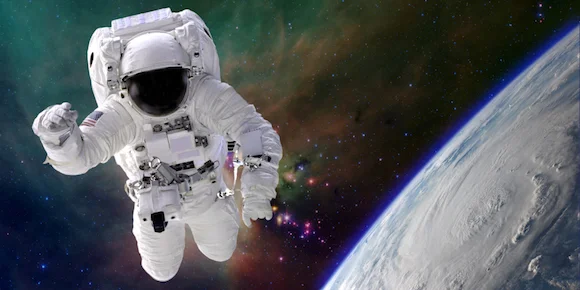Since November 2000, groups of astronauts and cosmonauts have lived on the International Space Station for six months at a time.
Now that NASA has retired its fleet of shuttles, they travel there and home again on a Russian spacecraft.
How is living in space different from living on Earth?
A space shuttle being launched. Once in space the rocket falls away and the shuttle continues towards the International Space Station. NASA space shuttles were retired in 2011. Image©Getty
Washing and going to the toilet
Water cannot flow in zero gravity, so the space station doesn’t have taps or showers like those on Earth. Astronauts clean themselves by wiping their bodies with a wet towel that has been soaked in liquid soap. To wash their hair they use special waterless shampoo that doesn’t need rinsing out. They use dry towels afterwards.
The toilet looks similar to those on Earth, but the opening is about 10cm in diameter, and as their bodies are floating in the zero gravity, astronauts use a special gadget fitted with a camera to guide them to the correct place. They then strap themselves onto the toilet so they don’t float away. They then use a machine similar to a vacuum cleaner to suck up the wastes, which are then vacuum-dried.
Sleeping
In zero gravity, astronauts can sleep in any position. Space shuttle and space station crews usually sleep in sleeping bags. They attach themselves to a bed, seat or wall in the cabin so they don’t float around.
On the International Space Station there are two small cabins, each just big enough for one person. Inside both there is a sleeping bag and a large window to look out of.
On the space shuttle, astronauts can sleep in the commander's seat, the pilot's seat or in one of the four bunk beds. There are only four bunk beds in the space shuttle. On missions with five or more astronauts, some crew members have to sleep in a sleeping bag attached to their seats or to a wall. It is difficult to sleep on the shuttle because there is a sunrise every 90 minutes.
Astronauts are scheduled for eight hours of sleep at the end of each mission day. Sleep can be difficult for astronauts due to motion sickness or being confined in close quarters with other sleepers. An alarm clock wakes the sleeping astronauts on the space station, but those sleeping on the shuttle are woken when Mission Control plays music for them.
Food
Astronauts eat three meals a day - breakfast, lunch and dinner. The food they eat provides them with a balance of vitamins and minerals.
There is no refrigeration in the space station or space shuttle, so space food must be stored and prepared properly to avoid spoilage, especially on longer missions. Food preparation depends on the type of food. Some foods, such as fruit, can be eaten without preparation. Other foods require some preparation, usually the addition of water. Both the space shuttle and the space station have an oven to heat food. Salt and pepper are available in a liquid form because sprinkling them is impossible: they would float away and could clog equipment or get in people’s eyes and noses.
Space Food! ©Getty
Drinks range from coffee, tea, orange juice, fruit punches and lemonade.
Space food comes in packages. Some packages prevent food from floating away, and are designed to be easy to sue. Packaging is thrown into a rubbish compactor when used.
Exercise
On Earth, we move against the force of gravity. In space there is no gravity, and so bones and muscles can become weaker. Astronauts have special exercise equipment and must exercise for about two hours a day, strapped into the machine so they don't float away. They use a treadmill for running exercises and an ergometer for pedalling exercises.
It’s a good idea to get information from more than one source!
Watch a video about the way astronauts live in space: sleeping, eating and sleeping
Read more about living in space:
http://iss.jaxa.jp/kids/en/index.html





